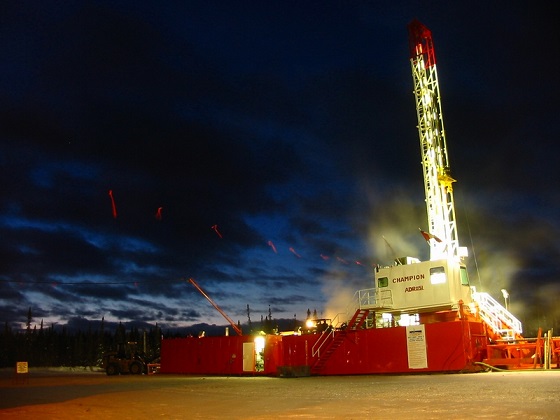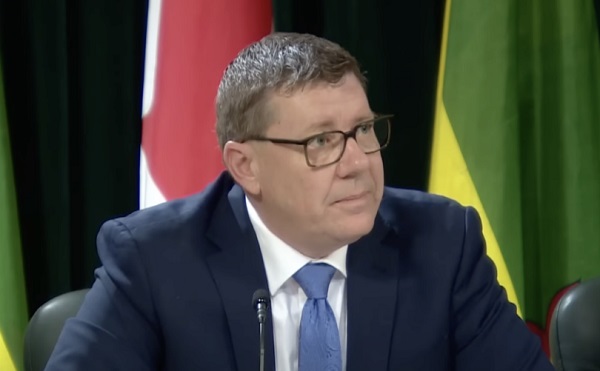Energy
Canada Embracing Carbon Capture and Storage (CCS) to Reduce Emissions and Sustain Energy Industry

From EnergyNow.ca
Alberta has firmly led the Canadian charge on CCS. It has more CO2 storage capacity than Norway, Korea, India, and double the entire Middle East, according to the Global CCS Institute.
Back in 2007, the Alberta and federal governments established a task force on carbon capture and storage (CCS) as a way of reducing emissions from oil, gas, and energy operations. That led to a report in 2008 that said: “CCS is seen as a technological solution that allows Canada to continue to increase its energy production while reducing (carbon dioxide) emissions from these activities. . . .
“CCS is strategically important to Canada for several reasons. First and foremost, Canada is endowed with an abundance of fossil fuels (including an unparalleled oil sands resource).”
The task force noted that public support for CCS was high, with 64% of the public being open to the idea of government financial support for CCS. All that happened under the Conservative Stephen Harper government, which, in 2015, lost power to the Justin Trudeau Liberals.
Trudeau himself went on to say in 2017 these memorable words: “No country would find 173 billion barrels of oil in the ground and leave them there.”
That’s not a message repeated since, and certainly not by his relentless minister of environment and climate change, Steven Guilbeault. On CCS, Guilbeault maintains that while carbon capture and storage “is happening in Canada,” it is not the “be-all and end-all.”
Much more positively, we now have Jonathan Wilkinson, Canada’s energy and natural resources minister, saying he expects 20 to 25 commercial-scale CCS projects to break ground in Canada within the next decade.
And we finally have what Ottawa first promised in 2021: a system of tax credits for investments in carbon capture — which industry sees as a way to get those 20 to 25 carbon-capture projects built.
The tax incentive covers up to 50 per cent of the capital cost of CCS and CCUS carbon-capture projects. Although energy company Enbridge points out that tax incentives in the U.S. are more attractive than what Canada is offering.
“CCUS” is one of the carbon-capture models. It stands for Carbon Capture Use and Storage or Carbon Capture Utilization and Sequestration. Under CCUS, captured carbon dioxide can be used elsewhere (for example, to increase the flow from an oilfield, or locked into concrete). Or it can be permanently stored underground, held there by rock formations or in deep saltwater reservoirs.
Canada’s climate plan includes this: “Increased use of CCUS features in the mix of every credible path to achieving net zero by 2050.”
As well, the feds have supported a couple of smaller CCS projects through the Canada Growth Fund and its “carbon contract for difference” approach.
To date, Alberta has firmly led the Canadian charge on CCS. It has more CO2 storage capacity than Norway, Korea, India, and double the entire Middle East, according to the Global CCS Institute.
 From the Alberta government’s Canadian Energy Centre
From the Alberta government’s Canadian Energy Centre
In the most recent move in Alberta, Shell Canada announced it is going ahead with its Polaris carbon capture project in Alberta. It is designed to capture up to 650,000 tonnes of carbon dioxide annually from Shell’s Scotford refinery and chemicals complex near Edmonton.
That works out to approximately 40 per cent of Scotford’s direct CO2 emissions from the refinery and 22 per cent of its emissions from the chemicals complex.
Shell’s announcement sparked this from Wilkinson: “The Shell Polaris announcement last week was a direct result of the investment tax credit.”
Also in Alberta, the Alberta government notes: “The Alberta government has invested billions of dollars into carbon capture, utilization and storage (CCUS) projects and programs. . . . The Alberta government is investing $1.24 billion for up to 15 years in the Quest and Alberta Carbon Trunk Line (ACTL) projects.”
Quest is Shell’s earlier Scotford project. “The project is capturing CO2 from oil sands upgrading and transporting it 65 km north for permanent storage approximately 2 km below the earth’s surface. Since commercial operations began in 2015, the Quest Project has captured and stored over 8 million tonnes of CO2.”
The Alberta Carbon Trunk Line is a 240-km pipeline that carries CO2 captured from the Sturgeon Refinery and the Nutrien Redwater fertilizer plant to enhanced oil recovery projects in central Alberta. Since commercial operations began in 2020, the ACTL Project has captured and sequestered over 3.5 million tonnes of CO2.
Shell and partner ATCO EnPower now plan a new CCS project at Scotford. And, on a smaller scale, Entropy Inc. will add a second phase of CCS at its Glacier gas plant near Grande Prairie.
And those are just two of Alberta’s coming CCS projects. That province is working on at least 11 more that could lead to over $20 billion in capital expenditures and reduce about 24 million tonnes of emissions annually — the equivalent of reducing Alberta’s annual industrial emissions by almost 10 per cent.
And then there’s the giant CCS project proposed by the Pathways Alliance, a partnership representing about 95% of Canada’s oil sands production.
“The project would see CO2 captured from more than 20 oil sands facilities and transported 400 kilometers by pipeline to a terminal in the Cold Lake area, where it will be stored underground in a joint carbon-storage hub. . . . A final investment decision is expected in 2025.”
Alberta alone has more CO2 storage capacity than Norway, Korea, India, and double the entire Middle East, according to the Global CCS Institute.
When Wilkinson spoke in favor of CCS, Capital Power had just backed away from building a carbon-capture facility at its Genesee power plant in Alberta. But Enbridge, which would have built the associated storage hub, is still “strongly interested.”
In Saskatchewan, which also offers government support for CCS, more than 5 million tonnes of CO2 have been captured at SaskPower’s Boundary Dam 3 power plant. “Someone would have to plant more than 69 million trees and let them grow for 10 years to match that.”
In B.C., natural gas company FortisBC offers small-scale carbon-capture technology to help businesses that use natural gas to save energy and decrease greenhouse gas emissions.
And the B.C. government says that, potentially, two to six large-scale CCS projects could be developed in northeast B.C. over the next decade.
“Small-scale operations currently exist in B.C. that inject a mixture of CO2 and H2S (hydrogen sulfide) deep into underground formations. This process, which is referred to as acid-gas disposal, already occurs at 12 sites.”
Elsewhere, CCS projects are operating or being developed around the world, including in Australia, Denmark, and the U.S. A CCS project in Norway has been in operation for 28 years.
It took a while to get the ball rolling in Canada, but CCS/CCUS is here to stay, reducing emissions and keeping industries alive to contribute to the economy.
2025 Federal Election
MORE OF THE SAME: Mark Carney Admits He Will Not Repeal the Liberal’s Bill C-69 – The ‘No Pipelines’ Bill

From EnergyNow.Ca
Mark Carney on Tuesday explicitly stated the Liberals will not repeal their controversial Bill C-69, legislation that prevents new pipelines being built.
Carney has been campaigning on boosting the economy and the “need to act forcefully” against President Donald Trump and his tariffs by harvesting Canada’s wealth of natural resources — until it all fell flat around him when he admitted he actually had no intention to build pipelines at all.
When a reporter asked Carney how he plans to maintain Bill C-69 while simultaneously building infrastructure in Canada, Carney replied, “we do not plan to repeal Bill C-69.”
“What we have said, formally at a First Ministers meeting, is that we will move for projects of national interest, to remove duplication in terms of environmental assessments and other approvals, and we will follow the principle of ‘one project, one approval,’ to move forward from that.”
“What’s essential is to work at this time of crisis, to come together as a nation, all levels of government, to focus on those projects that are going to make material differences to our country, to Canadian workers, to our future.”
“The federal government is looking to lead with that, by saying we will accept provincial environmental assessments, for example clean energy projects or conventional energy projects, there’s many others that could be there.”
“We will always ensure these projects move forward in partnership with First Nations.”
Tory leader Pierre Poilievre was quick to respond to Carney’s admission that he has no intention to build new pipelines. “This Liberal law blocked BILLIONS of dollars of investment in oil & gas projects, pipelines, LNG plants, mines, and so much more — all of which would create powerful paychecks for our people,” wrote Poilievre on X.
“A fourth Liberal term will block even more and keep us reliant on the US,” he wrote, urging people to vote Conservative.
Alberta
Energy sector will fuel Alberta economy and Canada’s exports for many years to come

From the Fraser Institute
By any measure, Alberta is an energy powerhouse—within Canada, but also on a global scale. In 2023, it produced 85 per cent of Canada’s oil and three-fifths of the country’s natural gas. Most of Canada’s oil reserves are in Alberta, along with a majority of natural gas reserves. Alberta is the beating heart of the Canadian energy economy. And energy, in turn, accounts for one-quarter of Canada’s international exports.
Consider some key facts about the province’s energy landscape, as noted in the Alberta Energy Regulator’s (AER) 2023 annual report. Oil and natural gas production continued to rise (on a volume basis) in 2023, on the heels of steady increases over the preceding half decade. However, the dollar value of Alberta’s oil and gas production fell in 2023, as the surging prices recorded in 2022 following Russia’s invasion of Ukraine retreated. Capital spending in the province’s energy sector reached $30 billion in 2023, making it the leading driver of private-sector investment. And completion of the Trans Mountain pipeline expansion project has opened new offshore export avenues for Canada’s oil industry and should boost Alberta’s energy production and exports going forward.
In a world striving to address climate change, Alberta’s hydrocarbon-heavy energy sector faces challenges. At some point, the world may start to consume less oil and, later, less natural gas (in absolute terms). But such “peak” consumption hasn’t arrived yet, nor does it appear imminent. While the demand for certain refined petroleum products is trending down in some advanced economies, particularly in Europe, we should take a broader global perspective when assessing energy demand and supply trends.
Looking at the worldwide picture, Goldman Sachs’ 2024 global energy forecast predicts that “oil usage will increase through 2034” thanks to strong demand in emerging markets and growing production of petrochemicals that depend on oil as the principal feedstock. Global demand for natural gas (including LNG) will also continue to increase, particularly since natural gas is the least carbon-intensive fossil fuel and more of it is being traded in the form of liquefied natural gas (LNG).
Against this backdrop, there are reasons to be optimistic about the prospects for Alberta’s energy sector, particularly if the federal government dials back some of the economically destructive energy and climate policies adopted by the last government. According to the AER’s “base case” forecast, overall energy output will expand over the next 10 years. Oilsands output is projected to grow modestly; natural gas production will also rise, in part due to greater demand for Alberta’s upstream gas from LNG operators in British Columbia.
The AER’s forecast also points to a positive trajectory for capital spending across the province’s energy sector. The agency sees annual investment rising from almost $30 billion to $40 billion by 2033. Most of this takes place in the oil and gas industry, but “emerging” energy resources and projects aimed at climate mitigation are expected to represent a bigger slice of energy-related capital spending going forward.
Like many other oil and gas producing jurisdictions, Alberta must navigate the bumpy journey to a lower-carbon future. But the world is set to remain dependent on fossil fuels for decades to come. This suggests the energy sector will continue to underpin not only the Alberta economy but also Canada’s export portfolio for the foreseeable future.
-

 2025 Federal Election1 day ago
2025 Federal Election1 day agoPM Carney’s Candidate Paul Chiang Steps Down After RCMP Confirms Probe Into “Bounty” Comments
-

 International22 hours ago
International22 hours agoTrump’s ‘Golden Dome’ defense shield must be built now, Lt. Gen. warns
-

 2025 Federal Election2 days ago
2025 Federal Election2 days agoRCMP Confirms It Is ‘Looking Into’ Alleged Foreign Threat Following Liberal Candidate Paul Chiang Comments
-

 2025 Federal Election1 day ago
2025 Federal Election1 day agoFight against carbon taxes not over yet
-

 Business1 day ago
Business1 day agoSaskatchewan becomes first Canadian province to fully eliminate carbon tax
-

 2025 Federal Election1 day ago
2025 Federal Election1 day agoMark Carney refuses to clarify 2022 remarks accusing the Freedom Convoy of ‘sedition’
-

 Automotive1 day ago
Automotive1 day agoElectric cars just another poor climate policy
-

 2025 Federal Election1 day ago
2025 Federal Election1 day agoLiberal MP Paul Chiang Resigns Without Naming the Real Threat—The CCP






